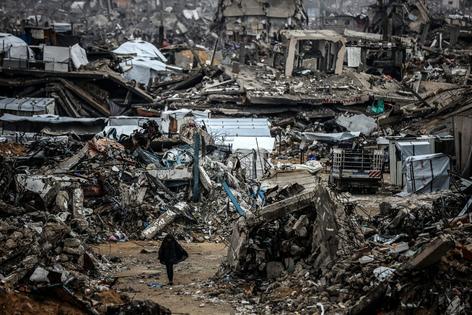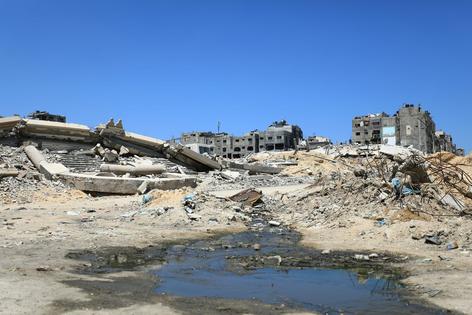Israel’s bombing of Gaza caused untold environmental damage − recovery will take effort and time
Published in Political News
The war in Gaza has come with an awful cost. Tens of thousands of Palestinian civilians have been killed, and thousands more are missing. And while a temporary ceasefire has allowed for increased aid delivery, easing the plight of those facing disease and hunger, experts predict malnutrition and health issues to persist for months or even years.
Much of the territory’s infrastructure – its schools, hospitals and homes – has been damaged or destroyed. And yet, the tremendous human and societal loss has been augmented by a lesser reported but potentially catastrophic, consequence: environmental devastation.
In June 2024, the United Nations Environment Programme conducted an environmental impact assessment to evaluate the damage resulting from Israeli military actions in Gaza. It found “unprecedented levels of destruction” from the intensive bombing campaign, along with the complete collapse of water and solid waste systems, and widespread contamination of the soil, water and air. And that was before another six months of bombing caused further damage to Gaza.
As a scholar of environmental justice, I have thought carefully about the impact that a lack of clean water, access to sanitation facilities, and the absence of basic infrastructure can have on a community, particularly vulnerable and marginalized populations. The current pause in fighting is providing respite for the 2.2 million people in Gaza who have endured more than a year of war. It also provides an opportunity to evaluate the environmental damage to the densely populated enclave in three crucial areas: the water, sanitation and hygiene sector, or WASH; air quality; and waste management.
Here is what we know so far:
According to an interim damage assessment released by the World Bank, U.N. and E.U. in March 2024, an estimated US$502.7 million of damage was inflicted on the WASH sector in Gaza in the initial months of bombing, including damage to approximately 57% of the water infrastructure.
The United Nations reported that water desalination plants in Gaza, 162 water wells and two of the three water connections with Israel’s national water provider had been severely damaged.
As a result, the amount of available water in Gaza was at that point reduced to roughly 2-8 liters per person per day – below the World Health Organization emergency daily minimum of 15 liters and far below its standard recommendation of 50-100 liters per day.
In November 2024, meanwhile, the charity Oxfam reported that all five wastewater treatment plants in Gaza had been forced to shut down, along with the majority of its 65 wastewater pumping stations. This resulted in ongoing discharges of raw, untreated sewage into the environment. As of June 2024, an estimated 15.8 million gallons of wastewater has been discharged into the environment in and around Gaza, according to the U.N. environmental report.
Meanwhile, sanitation facilities for Palestinians in Gaza are practically nonexistent. Reporting from U.N. Women states that people in Gaza routinely walk long distances and then wait for hours just to use a toilet, and due to the lack of water, these toilets cannot be flushed or cleaned.
The air quality in Gaza has been drastically impacted by this war. NASA satellite imagery from the first few months of the war found that approximately 165 fires were recorded in Gaza from October 2023 to January 2024.
With a shortage of electricity, residents have been forced to burn various materials, including plastics and household waste, for cooking and heating. And this has contributed to a dangerous decline in air quality.
Meanwhile, large amounts of dust, debris and chemical releases have been produced from explosions and the destruction of infrastructure, leading to significant air pollution. In February 2024, the U.N. Mine Action Service estimated that, in the first few months of the war alone, more than 25,000 tons of explosives had been used, equivalent to “two nuclear bombs.”
In the first six months of bombardment, more than 39 million tons of debris were generated, much of it likely to contain harmful contaminants, including asbestos, residue from explosives and toxic medical waste.
Human remains are also mixed in with this debris, with estimates that over 10,000 bodies remain under the rubble. Moreover, the three main landfills in the Gaza Strip have been closed and are unable to receive waste or conflict-related debris.
Substantial damage has been done to five out of six solid waste management facilities, and solid waste continues to accumulate at camps and shelters, with an estimate of 1,100 to 1,200 tons being generated daily.
With such environmental destruction, claims of “ecocide” have been made against the Israeli government by international rights groups.
Although not presently incorporated into the framework of international law, there have been recent efforts for ecocide to be added as a crime under the Rome Statute, the treaty that established the International Criminal Court. Indeed, a panel of experts in 2021 proposed a working definition of ecocide as “unlawful or wanton acts committed with knowledge that there is a substantial likelihood of severe and either widespread or long-term damage to the environment caused by those acts.”
To date, 15 countries have criminalized ecocide, and Ukraine is investigating Russia for ecocide for its destruction of the Kakhovka Dam in 2023.
Various organizations, including the Al Mezan Center for Human Rights, the University of California Global Health Institute and the Women’s International League for Peace and Freedom, have stated that the level of environmental devastation in Gaza reaches the proposed legal definition of “ecocide.”
Although the Israeli government has not responded to these accusations, it has consistently stated that it has a right to defend itself and that it seeks to protect civilians as it conducts its military operations.
Regardless of whether the charge of ecocide applies to Israel’s bombardment of Gaza, the environmental impact, the spread of disease, and other harmful health impairments will be felt for years to come.
The United Nations Relief and Works Agency reported an increase in hepatitis A in the enclave, from 85 cases before the current war to 107,000 cases in October 2024. The WHO has reported 500,000 cases of diarrhea and 100,000 cases of lice and scabies, along with the reemergence of polio.
The lack of adequate WASH facilities has also disproportionately affected women and girls by interfering with basic menstrual hygiene, harming their mental and physical health.
Meanwhile, the increased presence of dangerous air pollutants has led to increases in respiratory issues, including nearly 1 million acute respiratory illnesses. Presently, the most common respiratory ailments in Gaza are asthma, chronic obstructive pulmonary disease, bronchitis, pneumonia and lung cancer.
As a licensed environmental engineer, I have never seen the scale of environmental destruction that has occurred in Gaza.
While the situation is unprecedented, there are concrete steps that the international community can take to help Gaza’s environment recover. The three-stage ceasefire agreement between Israel and Hamas, which went into effect on Jan. 19, 2025, is a promising first step. This agreement has allowed some Israeli hostages to be released and Palestinian detainees to return to their homes. It also allows for more humanitarian aid to enter Gaza to deal with the current food crisis and health emergency.
Nevertheless, there are significant challenges ahead for the people of Gaza. First, the ceasefire agreement will need to hold – and already there are signs of difficulty in implementing the agreement in full. Should fighting resume, that will close or delay the opportunity for engineers and surveyors to perform detailed, comprehensive field assessments.
Meanwhile, the need for a post-conflict plan for Gaza has never been starker.
Recovering from Gaza’s environmental devastation will require Israel and neighboring countries, as well as influential world powers such as the United States and the European Union, to work together to rebuild critical infrastructure, such as water and wastewater treatment plants and solid waste infrastructure. Moreover, to succeed, any long-term plan for the reconstruction of Gaza will need to prioritize the needs and perspectives of Palestinians themselves.
This article is republished from The Conversation, a nonprofit, independent news organization bringing you facts and trustworthy analysis to help you make sense of our complex world. It was written by: Lesley Joseph, University of South Carolina
Read more:
Gaza’s next tragedy: Disease risk spreads amid overcrowded shelters, dirty water and breakdown of basic sanitation
Decades of underfunding, blockade have weakened Gaza’s health system − the siege has pushed it into abject crisis
New report slaps an official price tag on Australia’s precious natural assets
Lesley Joseph does not work for, consult, own shares in or receive funding from any company or organization that would benefit from this article, and has disclosed no relevant affiliations beyond their academic appointment.
































































Comments